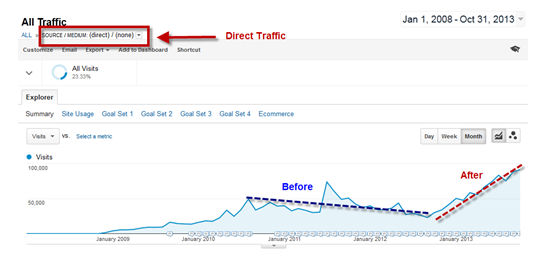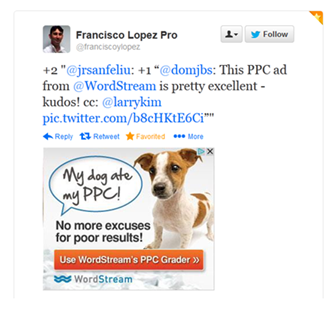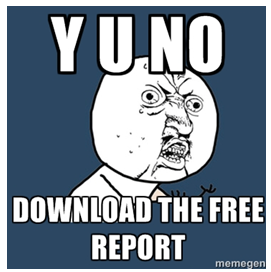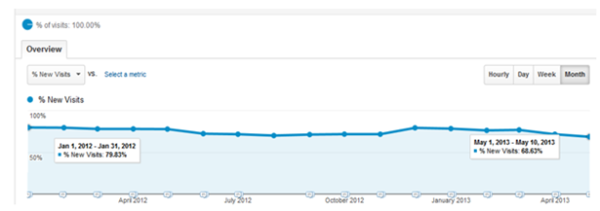3 Surprising Benefits Of Retargeting
As retargeting becomes more widely used and better understood, its reputation is improving. Marketers are learning to avoid creeping people out through better targeting and less intrusive messaging. Early adopters now have a year or two (or more) of experience to share, which is exactly what I intend to do today. At Wordstream, we’ve been […]
As retargeting becomes more widely used and better understood, its reputation is improving. Marketers are learning to avoid creeping people out through better targeting and less intrusive messaging. Early adopters now have a year or two (or more) of experience to share, which is exactly what I intend to do today.
At Wordstream, we’ve been using retargeting with Google AdWords since Q1 2012. Though we expected it could help us with a few specific issues, it’s surprised us with a few additional benefits, as well.
First, what is retargeting? In a nutshell, it’s the process of tagging website visitors so you can target them specifically, with ads tailored to their level of interest in your company, across an advertising network.
This means you might appear in front of them again while they’re watching YouTube videos, shopping online, using social media or searching for information. You can segment visitors into groups and use ad copy and images to appeal to them based on what they did on your site in the first place. Lionel White shared an excellent retargeting primer earlier this year on Search Engine Land.
By the time all was said and done, we determined that 18 months into our retargeting efforts, we had increased repeat visitors 50%, boosted conversion 51%, and saw 300% greater time on site! Retargeting helped us get back in front of people who had already expressed an interest in our site and do so in a very personalized way. Here’s how…
1. Heightened Brand Recall
The first surprising retargeting benefit for us was a big boost in brand recall. We had a problem contrary to what many companies experience: only 3% of our organic traffic came from branded searches. We had invested heavily in SEO — so much that we outpaced our brand by far. We were appearing in search and getting clicks, yet no one knew who we were.
Google’s [not provided] keyword data makes it pretty hard to trend brand searches over time, so we use direct traffic as a proxy. In the above chart, you can see our traffic over the past six years. It wasn’t until we implemented retargeting that we began to see a meaningful increase in direct traffic — people were expressing an interest in our brand and visiting the site directly. We were interacting more often with people who already knew what we were about and were interested in learning more.
Ad creative plays a huge role in brand recall, as well. Shoot for a CTR of at least 0.4% and test until you find the most memorable ad copy, title and image combinations for each audience segment. We had people share our ads via social media more than once — that’s a win!
2. Greater Engagement
Prior to our retargeting efforts, we had an embarrassingly low average time on site: just one minute and 34 seconds.
Visitors viewed 1.9 pages per visit, and our new visitor ratio was 79.2%. Clearly, we weren’t resonating with the people we did manage to attract to our site.
Retargeting allows you to reconnect in a meaningful way with people who, for one reason or another, cared enough to visit your site in the first place. On average, you’ll be able to get back in front of 84% of your tagged traffic, for a total of 10-18 additional exposures per month.
This is where segmentation and appropriate ad copy are critical. We began by creating different audiences, depending on what part of the site a person had visited. We could then tailor retargeting ad content to our best guess at their needs. For example, a person who visited our AdWords Grader for PPC auditing is probably seeking very different information than the person who landed on our homepage.
Over time, we’ve been able to test a ton of ad creative against a large variety of audiences we’ve created, based on what we can see tagged visitors doing on our site. Try targeting people based on the categories they prefer on your blog, for example.
We were able to increase engagement as measured by time on site over 300%, to almost five minutes a visit, simply by giving people who were already interested in our brand more of what they wanted to see from us.
3. Increased Conversion
This was certainly a goal we had in mind when we began retargeting, though it was surprising how effective it’s been.
Like a lot of other companies engaged in SEO and content marketing, one of our goals was to convert traffic to leads via offers for whitepapers, free trials, etc., on our site. Unfortunately for us, we were seeing less than 2% conversion.
Traffic wasn’t a problem; our investments in SEO and content have resulted in a compound monthly growth rate of over 8% every month for the last five years. However, we struggled to entice those visitors to connect with us on an ongoing basis. This isn’t a problem unique to us — Forrester says 96% of site visitors never convert to a lead or sale. We knew we had to find a way to get people to connect with us so we could nurture the lead, whether that was on their first visit or their fifteenth.
Bidding strategy is key here. We quickly found that it made sense to bid more aggressively on people who had shown greater intent while they were on our site. For example, someone who tried our product has shown far more intent than a person who read one of our blog posts. For a retailer, this might mean choosing to bid more on those who abandoned a cart than a visitor who browsed a few minutes and left.
Audience membership duration is important, too. You have to decide how long to “follow” your targets around the web. We used an aggressive 30 to 60 days, though you should test against the length of your sales cycle as a starting point, to find the right mix for you and your audience.
We were able to improve our website visitor-to-lead-form-submitted conversion by 51%, in addition to a 50% increase in the number of repeat visitors to our site. You’ll see this as a decrease in new visitors (see above), as people who were interested once return again and again for more.
SEO + Content Marketing + Retargeting = Maximum ROI
In 2014, I’ll be investing around a million dollars in my paid search efforts to market my products and services. Half of that ad budget will go towards display retargeting. Why? Because I already have hundreds of thousands of site visitors each month, largely due to our efforts in SEO and content marketing.
As far as I’m concerned, it would be insane to spend the amount of time and money we do on SEO, content marketing, paid search and social media without then following up with retargeting to maximize the value of those initial visits.
A searcher may get distracted while on site — they might lose interest, have to answer their phone, or fall down a viral video rabbit hole — you just don’t know. It’s your job (if you want to win their business) to seek that person out and give them a compelling reason to give your site another shot.
Have you tried retargeting using Google AdWords or another network? Has it had an impact on your content marketing efforts? Share your thoughts or questions in the comments!
Contributing authors are invited to create content for Search Engine Land and are chosen for their expertise and contribution to the search community. Our contributors work under the oversight of the editorial staff and contributions are checked for quality and relevance to our readers. The opinions they express are their own.
Related stories
New on Search Engine Land




